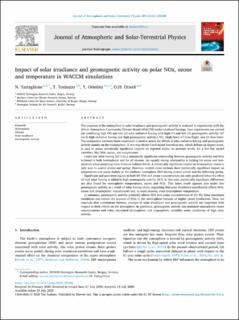| dc.contributor.author | Tartaglione, Nazario | |
| dc.contributor.author | Toniazzo, Thomas | |
| dc.contributor.author | Orsolini, Yvan J. | |
| dc.contributor.author | Otterå, Odd Helge | |
| dc.date.accessioned | 2021-05-28T07:39:20Z | |
| dc.date.available | 2021-05-28T07:39:20Z | |
| dc.date.created | 2020-07-30T19:02:20Z | |
| dc.date.issued | 2020 | |
| dc.identifier.citation | Journal of Atmospheric and Solar-Terrestrial Physics. 2020, 209, 105398. | en_US |
| dc.identifier.issn | 1364-6826 | |
| dc.identifier.uri | https://hdl.handle.net/11250/2756759 | |
| dc.description.abstract | The response of the atmosphere to solar irradiance and geomagnetic activity is analyzed in experiments with the Whole Atmosphere Community Climate Model (WACCM) under idealized forcings. Four experiments are carried out combining high (H) and low (L) solar radiative forcing with high (7) and low (3) geomagnetic activity: H7 (with high radiative forcing and high geomagnetic activity), H3, (high/low), L7 (low/high), and L3 (low/low). The comparison between these experiment is used to assess the effects of solar radiative forcing and geomagnetic activity mainly on the stratosphere. A two-step Monte Carlo-based statistical test, which defines an impact score, is used to assess statistically significant impacts on regional scales, on pressure levels, for a few key model variables, like NOx, ozone, and temperature. Under low solar forcing (L7/L3), a statistically significant relationship between geomagnetic activity and NOx is found in both hemispheres and for all seasons. An equally strong relationship is lacking for ozone and temperature when analyzing these fields on isobaric levels. A statistically significant impact on stratospheric ozone is only seen in austral winter and spring. However, vertical cross sections show statistically significant impact on temperature and ozone mainly in the southern hemisphere (SH) during austral winter and the following spring. Significant and persistent signals in both SH NOx and ozone concentrations are only produced when the effect of high solar forcing is added to high geomagnetic activity (H7). In this case, statistically significant differences are also found for mesospheric temperatures, ozone and NOx. This latter result appears also under low geomagnetic activity as a result of solar forcing alone, suggesting that solar irradiance significantly affects NOx, ozone and stratospheric temperatures and, in some seasons, even tropospheric temperature. In summary, geomagnetic activity primarily affects NOx and ozone concentrations in the SH. Solar maximum conditions can reduce the amount of NOx in the stratosphere because of higher ozone production. Thus, we conclude that correlations between changes in solar irradiance and geomagnetic activity are important with respect to their effects on the atmosphere. In particular, geomagnetic activity can modulate atmospheric ozone concentrations and other associated stratospheric and tropospheric variables under conditions of high solar activity. | en_US |
| dc.language.iso | eng | en_US |
| dc.rights | Navngivelse 4.0 Internasjonal | * |
| dc.rights.uri | http://creativecommons.org/licenses/by/4.0/deed.no | * |
| dc.title | Impact of solar irradiance and geomagnetic activity on polar NOx, ozone and temperature in WACCM simulations | en_US |
| dc.type | Peer reviewed | en_US |
| dc.type | Journal article | en_US |
| dc.description.version | publishedVersion | en_US |
| dc.rights.holder | © 2020 The Authors. Published by Elsevier Ltd. | en_US |
| dc.source.pagenumber | 16 | en_US |
| dc.source.volume | 209 | en_US |
| dc.source.journal | Journal of Atmospheric and Solar-Terrestrial Physics | en_US |
| dc.identifier.doi | 10.1016/j.jastp.2020.105398 | |
| dc.identifier.cristin | 1821082 | |
| dc.relation.project | NILU - Norsk institutt for luftforskning: 116104 | en_US |
| dc.relation.project | Norges forskningsråd: 255276 | en_US |
| dc.relation.project | Notur/NorStore: NS9206K | en_US |
| dc.relation.project | Notur/NorStore: NS9133K | en_US |
| dc.relation.project | Notur/NorStore: NN9206K | en_US |
| dc.relation.project | Notur/NorStore: NN9133K | en_US |
| cristin.ispublished | true | |
| cristin.fulltext | original | |
| cristin.qualitycode | 1 | |

